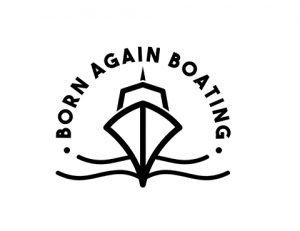If you have ever gone out to your car to find out that the battery is dead, it’s a bad feeling. If you have ever been out on the water on a boat and found that the battery died, it’s a horrible feeling! So, it begs the question.
Do Outboards Have Alternators & Do They Charge Batteries? Yes. Almost all outboards that have electric start and that were built in the last 20 years, will have either an alternator or a stater that charges the battery when the engine is running.
At what capacities and loads they charge the batteries is another thing. Here are a few pointers to think about when buying a boat with an outboard or setting up your boat and electronics.
Does the Horse Power Matter?
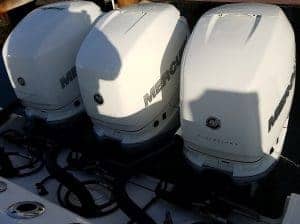 The reason most people talk about and ask about horsepower usually isn’t related to charging the boat’s batteries. But it really does matter! It actually matters a lot!
The reason most people talk about and ask about horsepower usually isn’t related to charging the boat’s batteries. But it really does matter! It actually matters a lot!
For an outboard alternator, the smaller the engine is, the less it is going to charge. Vice Versa, the larger the outboard horsepower, the more electricity it will be able to produce.
Also, understand that what type of battery is in the boat matters as well. A 15 HP engine on an 11′ boat doesn’t need to have a huge battery. There’s no need to have a Group 31 deep cycle battery on the boat. At least not to start the engine and run a couple of lights!
Smaller engines don’t need a lot of Marine or Cold Cranking Amps, (MCA & CCA). A 20 HP only needs to have like 350 MCA’s, or a 150 HP only needs 675 MCA. Whereas a 350 Verado recommends having an 800-1000 MCA and a Group 31 Absorbed Glass Mat battery!
So, a general rule of thumb is that the more horsepower, the more charging power, and the bigger the battery required.
Understanding Power Consumption
We also need to understand a little bit about power consumption. You don’t need to know all of the Amps, Volts, and Amp-hours that each item on your boat requires. However, you should think about what is being run.
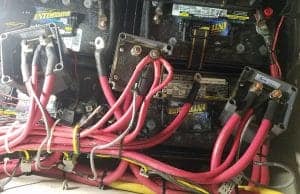 Batteries have a certain amount of time that they can produce an “x” amount of power. You can run a livewell pump for say 48 hours until the battery is completely dead. (These times are just general and don’t reflect real-time for any particular battery or pump)
Batteries have a certain amount of time that they can produce an “x” amount of power. You can run a livewell pump for say 48 hours until the battery is completely dead. (These times are just general and don’t reflect real-time for any particular battery or pump)
But the same battery and livewell pump can only run for 24 hours if the GPS is also running at the same time.
Then if we are running the livewell pump, the GPS, and playing the stereo, we can only run the livewell pump for 12 hours until the battery is dead. One step further, if running all those items, plus the VHF radio, now in only 6 hours that battery is going to be dead!
Obviously it will take a long time to kill the battery depending on your set up in your boat and what all you are running, but you get the point.
If the battery gets to a certain point, the engine won’t start. For instance, let’s say, in order to start the engine, it needs to be half charged; the 6 hours, then turns into 3!
It’s something to think about if you only have 1 battery in the boat, or if you have 2 batteries, how to use the battery switch. We’ll touch on that in a little bit.
What’s the Difference Between an Alternator & Stator?
There is actually a big difference between an alternator and a stator.
 For starters, a stator outputs Alternating Current (AC) voltage. And then needs to be sent through what is called a rectifier regulator, which changes it into Direct Current (DC).
For starters, a stator outputs Alternating Current (AC) voltage. And then needs to be sent through what is called a rectifier regulator, which changes it into Direct Current (DC).
All boats that have outboards mainly use DC voltage or battery power. Some are equipped to also have AC outlets on the boat, but most of the pumps, radios, stereos, GPS’s and electronics on the boat use DC.
The rectifier regulator also regulates the voltage that is sent to the battery. Stators put out such high amounts of electricity than if it were just sent straight to the battery, it would burn the battery and other components up.
So it is regulated to a certain voltage, usually around 13-15 VDC (Volts Direct Current). With the extra power being sent to the ground.
Whereas an Alternator has the rectifier regulator built into it. The alternator will produce DC directly out of it and also has the capabilities to put out a lot higher amperage or electricity compared to the stator.
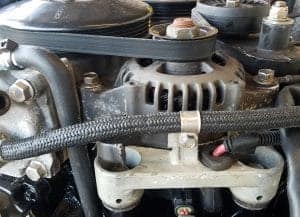 Alternators are also usually driven by a belt on the engine. Whereas the stator is under the flywheel creating electricity by using the magnets that are built into or glued onto the flywheel.
Alternators are also usually driven by a belt on the engine. Whereas the stator is under the flywheel creating electricity by using the magnets that are built into or glued onto the flywheel.
Which is Better Alternator or Stator?
The question can not be answered by information, it is more a matter of opinion. That is because half of the outboard manufacturers still use stators and at the time of this writing only three come with alternators.
Mercury Marine, Honda Outboards, and also Seven Marine have alternators. Suzuki and Yamaha still come with stators. Of course, all of the older engines, Johnson, Evinrude, Mariner, Force, Tohatsu, and etc. all have stators.
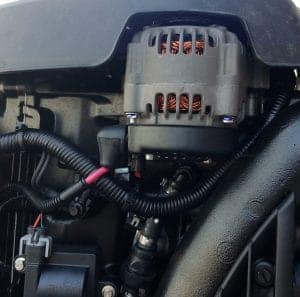 Most engineers and people will say that the alternator is better than the stator, because of the higher amperage capabilities. The more power the better, right? That is why most people will say that the alternator is better. Most alternators can produce 90 Amps! Which is a lot.
Most engineers and people will say that the alternator is better than the stator, because of the higher amperage capabilities. The more power the better, right? That is why most people will say that the alternator is better. Most alternators can produce 90 Amps! Which is a lot.
Therefore, as the center console and outboard boats become bigger and bigger, the engines can keep up the power offshore while running all of the screens, stereos, radios, pumps, and everything else that is being packed into a boat.
On the other hand, the stators are still good and reliable. There are still a ton of boats out there that don’t need all that power. Most people aren’t running 20″ GPS screens and 6 livewell pumps. With a stereo equipped with 4 Amps, 8 Subwoofers, and 16 speakers!
They only need to start the engine and run 1 GPS, a livewell pump, and a little radio. With more than one battery on board, the stator performs just fine!
Why Does a Boat’s Battery Die?
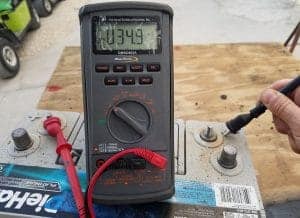 Since we have already talked about draining a battery by consumption, we are still left with the problem of what is called a “parasitic draw.” Which means that there is a drain on the battery, even when everything else is off.
Since we have already talked about draining a battery by consumption, we are still left with the problem of what is called a “parasitic draw.” Which means that there is a drain on the battery, even when everything else is off.
The best way to test this is with a Digital Voltage Meter, (DVA). Or just a plain old simple voltage meter. What you want to do is put the meter on DC voltage. Then, touch the black (negative) lead to the ground on the battery.
Then, place the red (positive) lead onto the MIDDLE OF THE BATTERY! See if there is any voltage flowing there.
Yes, the middle of the battery, a boat is a lot different from a car because of the environment that it is in.
There is a lot more moisture, water, condensation, dirt, and other stuff that can settle on the battery! With the moisture, condensation, and dirt build-up, the battery can drain itself just sitting there! So, if you have voltage flowing here, then clean the battery and it should go away!
Then, leaving the black lead on the negative post, put the red to the positive post and see what the battery voltage is. Make sure you remember this number!
 Now, hopefully, there is a battery switch somewhere in the boat. There should only be a couple of power cables coming directly from the battery.
Now, hopefully, there is a battery switch somewhere in the boat. There should only be a couple of power cables coming directly from the battery.
There should be a power cable going to the battery switch. A power cable with a fuse on it going to the bilge pump float switch. Then, there could be a battery charger lead. On Digital Throttle and Shift engines, there should be a clean power lead with another fuse.
On smaller boats, where there isn’t a switch, the engine cables could be going to the battery as well.
We need to go from each one of those cables and check for that battery voltage. That means pulling the battery switch and checking for power. If there is power going out from the switch when it is off, then the switch is either bad, or there is power back-feeding to it from somewhere.
This could take some time. However, in order to find where the parasitic draw is coming from, this is what has to be done.
Do You Need an Onboard Battery Charger?
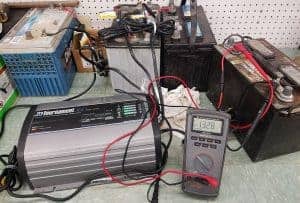 With so many different variables that can play into the answer, we’ll try and keep it simple!
With so many different variables that can play into the answer, we’ll try and keep it simple!
Onboard chargers are great, depending on your circumstances and electronics set up you have on the boat.
If you have a trolling motor, then the battery charger is a must! If you don’t have a trolling motor and are only running 1 or 2 things on the boat, then you can probably get away with not having a battery charger.
Also, utilizing a battery switch that allows you to turn off all the power to anything on the boat, can save your batteries.
The main thing about that is making sure that you know how to use the engine to charge the batteries and keep them maintained. We’ll talk about that in just a minute.
How To Test To See If Your Battery Is Charging
This is probably one of the main questions that will come up when talking about outboard alternators and stators.
Making sure that the engine is charging the battery is extremely quick and simple (depending on where the batteries are in your boat).
The only tool that we will need is our Voltage Meter that we talked about earlier. Put the meter to the battery, as we did earlier, to see what the voltage is directly at the battery itself.
 Get some water to the engine and turn it on to let it run. With the engine idling, check that voltage again. We should see the voltage a little higher than it was without the engine running.
Get some water to the engine and turn it on to let it run. With the engine idling, check that voltage again. We should see the voltage a little higher than it was without the engine running.
You can then advance the throttle to about 1200 RPM’s, (Be careful not to rev the engine up too high, if using the flush attachment opposed to a pair of earmuffs. We talk about this in another article which includes information about flushing your engine)
As the RPM’s come up, so should the voltage. The voltage should peak out somewhere around 14 VDC. Which is right where it should be.
Don’t worry if it is a little bit under that. It is ok. The main thing that we are concerned about is that the voltage climbs up as the RPM’s come up.
This lets us know that the engine is, in fact, charging the batteries the way it should.
How To Properly Wire & Use a Battery Selector Switch
Making sure that a battery switch is properly installed is vital to keeping your batteries from dying!
As we mentioned earlier, there are only a couple of things that should be directly connected to the actual battery.
 Including, a heavy gauge cable that goes to a battery switch, a wire with an inline fuse going to the bilge pump float switch, possibly clean power for a Digital Throttle & Shift system, then the battery charger if you have one.
Including, a heavy gauge cable that goes to a battery switch, a wire with an inline fuse going to the bilge pump float switch, possibly clean power for a Digital Throttle & Shift system, then the battery charger if you have one.
Besides this, almost everything else should be on either a breaker or a fuse, after a battery switch. Giving you the ability to turn all of the power to everything off, when you are not using the boat.
Now, adding batteries is the next thing. A lot of battery switches are a two-position switch. With settings of battery 1, battery 2, both, and off.
The power coming from the engine should go to either battery 1 or 2. Then all of the power coming out of the switch should leave from the common post.
Keeping all of the power from going out to the electronics. You can then parallel two of these switches if you have to say 4 batteries.
You will just put a single position switch between the two 4 position switches. Take a lead from one of the battery posts on each of the 4 positions.
Run them both to the single position, and voila! When you turn the two 4 position switches to both and turn the other single position on, it will combine all 4 batteries together!
What Position Should the Battery Switch Be in When Running the Engine?
Don’t skip this! This is probably one of the most important parts of running the boat when talking about battery juice. Especially when we are talking about offshore boating, reef fishing, or sandbar adventuring.
When the engine is running, like when you are headed to your fishing spot, sandbar, or the beach. You’ll want to run with the battery switch in the “both” position. That way, the engine will be charging all of your batteries at the same time.
Then, once you get where you are going, simply change the switch to either of the battery positions.
That way, as you are hanging out, fishing, or adventuring. You can run the radio, GPS, lights, pumps, whatever you want.
Then when it’s time to go, change the switch to the other battery and start the engine! You won’t have to worry about having a dead battery!
Now switch it to both as you run back and recharge the other battery back to full!
Of course, this only applies if there are two batteries in the boat. But, I would advise having two batteries for that exact reason!
Unless you are running say an 11-17′ boat. Two batteries are the way to go!
Check Us Out On YouTube!
Hopefully, this brings you up to speed on Outboards and Alternators! I hope you will check us out and look at some of our other posts and videos!
We cover a wide variety of boating and How-To service procedures, the correct way! We specialize in Outboards and all kinds of boating!
If you’ve got any questions or comments, let us know by subscribing to our YouTube Channel!
And if you would like to support us to continue bringing you great content, please click the link below to Amazon where we get a commission from anything you are already going to buy!
And you can also donate by clicking the donate button here or on the right hand of the screen!
It really helps us out and we thank you so much for your support!
If you have any questions, ask us there and we’re happy to help out when we can!
